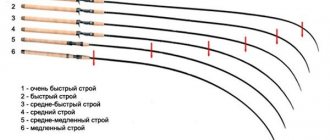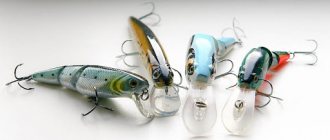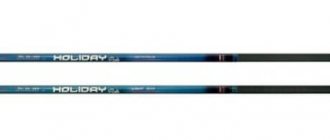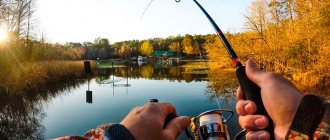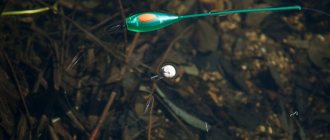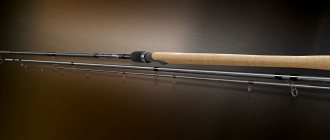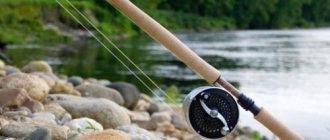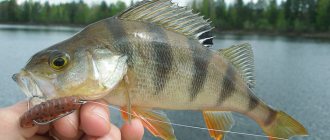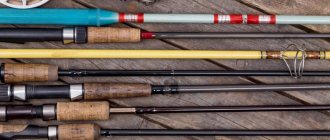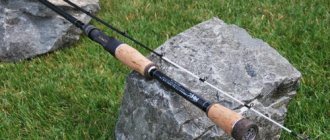Every person far from our hobby imagines a fisherman with this particular gear. The fly fishing rod is a kind of symbol of the entire community of fishing enthusiasts.
And indeed, most of us learned the basics of fishing, starting in early childhood by fishing with just such gear. Yes, and adult serious fishermen, who often prefer more “advanced”, from their point of view, feeder, spinning or fly fishing rods, are not averse to sitting on the shore with a simple float.
As you might have guessed, the topic of this article is what a fly rod is, how to choose it and assemble this tackle with your own hands. And our review also includes some aspects of direct swing fishing.
General information
A fly fishing rod is a float fishing rod, the casting of which is performed with a simple swing away from you. It can be equipped with rings and a reel, or contain a small reel, but basically it does without them. In this case, the fishing line is attached directly to the tip of the blank in different ways.
The components of the gear are a fly rod and float equipment. The fishing rod is used mainly for catching peaceful fish; rare amateurs use the swing for hunting perch or pike.
Attention! When fishing for pike with a fly rod, the rig is equipped with a rubber shock absorber to dampen sudden jerks of the predator. This element is placed between the tip and the main line.
Let's look at the components of a classic fly fishing rod.
Sabaneev Evolution
On average, you can buy it for 11,240 rubles.
The review of fly rods continues with a line of powerful and tough models that are deservedly popular among post-Soviet fishermen. Durable and rigid rods retain the sporting spirit of “Italian” rods. They are perfect for using heavy and medium-heavy gear, they will easily overpower large fish, and fishing with a jig with a side nod is also possible.
Rod
A modern fly rod is a telescopic blank from one and a half to eleven meters long without rings and a reel seat. Below we consider their main characteristics.
Length
The first thing that novice anglers need to pay attention to when choosing a fly rod is its length. This parameter is selected depending on the reservoir where fishing is planned and the expected trophy.
- Short rods up to three meters are most often used as onboard fishing rods, when the distance is short and there is not much space in the boat. And such gear can also be used for high-speed bleak fishing.
- Fishing rods up to five meters are most suitable in most cases. These are the main gear for fishing for crucian carp, tench or roach in the coastal zone, when the casting range does not exceed eight meters.
- The next largest sizes are forms with a length of 7-9 meters. It is not advisable for beginners to start with them, because rather bulky rods can create problems on a pond if they are not used to it.
- Rods longer than nine meters are classified as sports rods and are practically not used in amateur fishing. To achieve the required range, it is better to switch to a Bolognese or match fishing rod.
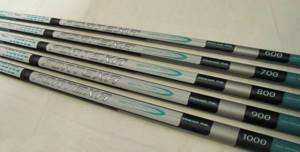
Flying rods of various lengths, in the photo it is indicated in centimeters.
Test
The fly rod rig is not heavy, so the rods rarely have a lot of test. Most often, the lower limit in grams does not numerically exceed the length of the form in meters. It is according to this indicator that you should select a fishing rod so that the weight of the equipment is slightly greater than the minimum and much lighter than the maximum.
Example! If your equipment, including float, weight and bait, weighs eight grams, you should select a fishing rod with a weight of approximately 5-15 grams.
Types of fishing rods
They have a fairly wide range of applications, and therefore are endowed with many different modifications. Each of which has its own unique characteristics.
There are 3 main varieties:
- Classic . The most common length is up to 13 m. Very powerful, thanks to its design and the flexibility of the material used, you can easily pull out a trophy weighing 5 kg.
- Ukleichnoe . They received this name after repeated sporting competitions where they caught bleak on them. The length reaches 4 m. They are quite light and thin. The handle is made of high-quality materials and has a slight thickening of up to 30 cm. This thickening is made to increase comfort.
- Karpovoe . They are not widely used due to their very large size: from 7 to 14 m. They are quite heavy, so they usually catch fish from special stands.
Popular rod models
Let's make a small rating of the most popular fly rods.
Mikado Princess 600
This famous fishing rod is distinguished by its excellent blank design and relatively low price. Many beginners begin mastering fly tackle with this six-meter gauge.
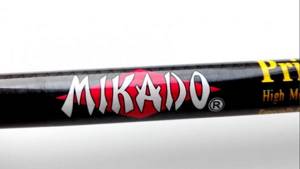
Mikado Princess 600 is an example of an inexpensive fly rod for amateur fishing.
On a note! This model is inexpensive, on average about six hundred rubles.
Volzhanka Fortuna 500
Another budget fly rod is the Volzhanka Fortuna 500. Made from IM6 carbon, it weighs only 270 grams and has a test weight of up to 30 grams.

The design consists of five bends, the transport length is 122 centimeters.
You can buy a Volzhanka Fortuna 500 fishing rod for just one and a half thousand rubles.
Daiwa Ninja Tele Pole
A well-known manufacturer of fishing tackle, the Daiwa company also has fly rods in its assortment. One example of successful solutions is the Daiwa Ninja Tele Pole fishing rod. The line includes four sizes of forms - from three to six meters.
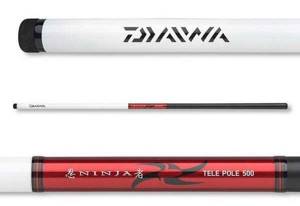
The five-meter model weighs only 230 grams!
Shimano Vengeance AX TE 5
Let’s finish our top list of rods with a blank from Shimano. The Vengeance AX TE 5 model belongs to the mid-price category, but its characteristics are impressive.
The test of graphite blanks is 4-20 grams, which allows you to work with a wide range of equipment.
The rod itself turned out to be light and sensitive, but at the same time it has a solid reserve of power, which is especially good when fighting large fish.
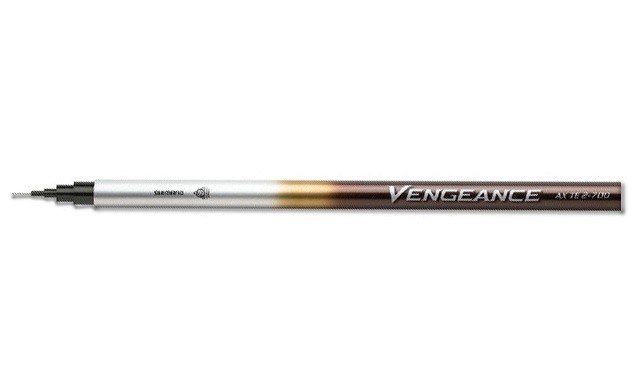
The price of Vengeance AX TE forms ranges from five to nine thousand rubles, depending on the size.
Volzhanka Modern
Cost, on average - 2,344 rubles.
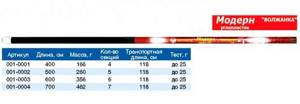
In fifth place in the ranking of the best fly rods is a lightweight, plastic telescopic model of good quality. It is very convenient for her to hook fish, as the swing is light and sharp. Excellent sensitivity when playing. At the same time, the high safety margin makes Volzhanka Modern one of the best offers in its price range.
Equipment
The equipment of a classic fly fishing rod includes several elements:
- connector;
- main line;
- float;
- loading;
- leash;
- hook.
Below we will talk about each of the elements. Moreover, we will consider them in the order of installation of the equipment.
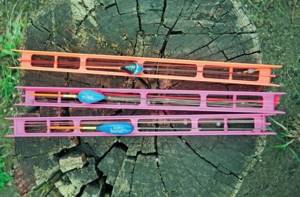
The equipment of fly rods is stored on special plastic reels.
Connector
When equipping a fly fishing rod, they begin by gluing a special connector to the tip for attaching the fishing line. You can, of course, attach the equipment to a fishing line loop, but this is not so practical and functional.
The connector is a small plastic device that allows you to quickly mount and remove equipment from the form. It is glued with any waterproof glue. Its lower part is movable, allowing you to open or close the plastic hook.
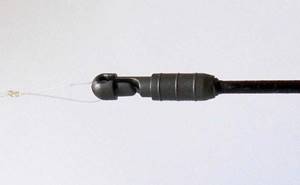
The connector is selected depending on the diameter of the rod tip.
Main line
After the connector, a fishing line is installed. A simple double loop is made at its end and thrown over the hook, after which the coupling is pushed onto the attachment point, as shown in the previous figure.
The diameter of the base is chosen depending on the weight of the intended trophy. Modern nylon monofilament lines are quite strong, so it is advisable to use the thinnest veins.
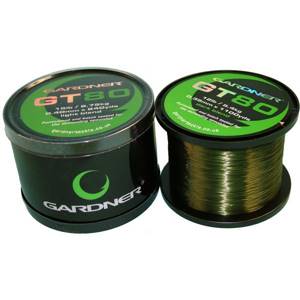
If you are going after small fish weighing up to a kilogram, a diameter of 0.08 millimeters will be sufficient.
When catching larger fish, you can increase the thickness of the fishing line, but still, from experience, we will say that they do not use more than 0.14 millimeters in fly fishing.
Attention! The total length of the fishing line with the leash should be 10-30 centimeters shorter than the rod. This is important for proper casting.
Float
Floats on a fly fishing rod are used depending on the situation on the pond. The lightest of them are used in still, calm water. As the wind strength increases, it would be correct to change the equipment to a heavier one.
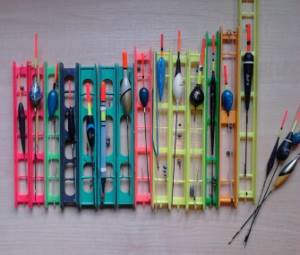
It is necessary to have a set of equipment with different weights and shapes of floats for quick replacement.
Attention! On a fly rod, floats have two or three attachment points.
If fishing takes place on the current of a river, then floats of a special shape should be used, especially when fishing is carried out with retrieval.
Loading
The weight of the float in the fly tackle is of great importance. If done incorrectly, the balance and sensitivity of the gear will be disrupted.
It is necessary to rely, first of all, on the carrying capacity of the float indicated on its body. Then, selecting pellets by weight and quantity, you need to achieve the correct position in the water.
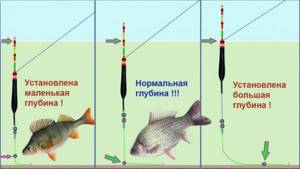
The photo clearly shows what position the float occupies when properly loaded.
As for the distribution of pellets along the fishing line, it depends on how the fisherman wants to deliver the bait to the pond:
- if leveling is required in the water column, then the loads move upward;
- in order for the bait to fall quickly, we move the pellets down;
- Even distribution is necessary to provoke a bite at mid-water.
Leash
A leash on a fly fishing rod is made if the thickness of the base is more than 0.10 millimeters. In this case, the rule of two hundredths of a millimeter is observed: for example, if the base is -0.14, the leash is 0.12.
Hook
The choice of hook on the fly tackle depends, as in other similar cases, on the size of the bait used and the size of the expected catch. Moreover, in the first case they look at the size of the hook, in the second - at the thickness of the wire.
Installation of equipment
It is advisable to immediately equip them with various equipment options that will be suitable for different fishing conditions. This is done in advance and screwed onto the reel. You definitely need to have a couple of rig options, with different lengths of the main line.
Whether it is used when removing the knees of the form will depend on:
- depth of the reservoir;
- casting distance.
The tackle is made 27-35 cm less than the length of the form. This is essential for a good swing. Prepare several equipment at once: rod-shaped and equipment that is equipped with a round float.
But the most important thing is the options for loading the gear; it sets several options for equipment for a variety of fishing:
- To fish in all layers of water, equipment with a light load is constructed, and several pellets are evenly distributed along the fishing line. When casting, it goes to the bottom slowly, smoothly and as it follows, it will attract all the fish from the upper water to the lower water.
- To hunt for fish in the middle layers of water you need to: place the load with the so-called disturbed uniformity, move the pellets a little towards the under-grazing. The weight of the weights should decrease as they approach the metal hook.
- When fishing occurs in the bottom part, with a depth of about 3 m and with an intense current: install a heavy weight, with special pellets regulating it from below.
- If there is a lot of vegetation in the reservoir, then punching equipment is used: the load is placed compactly, and a special float is tied with a larger load capacity. We must not forget that very light equipment is of little use here, due to the impossibility of casting accurately.
Fishing technique
Casting
How to make equipment for carp with your own hands
The fly rod is easy to control. The main thing is to make the correct cast. In this case, two methods are used:
- pendulum;
- through yourself.
Pendulum casting is performed as follows:
- Take the rod in the right fishing rod 20-30 centimeters from the butt.
- On the left - they hold the equipment in the under-grazing area.
- The fishing rod is held horizontally and directed towards the fishing point.
- Make a swing with your right hand, simultaneously releasing the fishing line.
- They accompany the flight of the equipment with the rod, lowering it back to a horizontal position.
- Place the fishing rod on the stand.
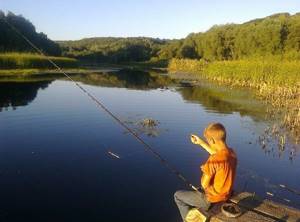
When preparing for a request, you need to carefully examine the condition of the gear and bait.
Attention! Pendulum casting is used in 90% of cases when fishing with a fly rod.
Casting over oneself, common in spinning rods, feeders, lap-dogs and matches, is an additional method in float fly fishing. It is mainly used in windy conditions on a pond, when the equipment is very saily. In this case, you need to monitor what is happening behind the angler.
Fishing
Fishing with a fly rod is also performed in two ways. The first one is a simple lifting of the rod. This works when the weight of the prey is small, up to about two hundred grams. If the tackle is set up correctly, then when the fishing rod is lifted vertically, the hooked fish itself flies into the angler’s hand.
When the mass of the caught trophy is large enough, you should use a landing net. At the same time, they make a hook and gradually pull the prey to the shore, trying to get it into the landing net.

The length of the landing net handle should be commensurate with the height of the fishing rod in order to catch the fish as far as possible from the shore.
Selection and installation of gear
The rod consists of a blank divided into segments. The smaller the number of sections, the lighter the weight of the fishing gear. The main quality criterion, which also affects the weight, is the material. The best models are made from carbon fiber, a durable and ultra-light raw material; many manufacturers use fiberglass and composite (a hybrid obtained by using several elements). One of the most famous is the Mikado company. The next parameter is length. First of all, the growth of the fishing rod depends on the fishing location: if the edge is close to the shore, you need to start fishing here, since underwater inhabitants prefer to stick to such bottom irregularities. An excellent solution would be a plug-in model, in which one or two elbows can be removed if necessary. As a rule, they are produced up to 11 m long.
Advantages of fly fishing:
- minimum weight of the rod that even a child can handle;
- instant replacement of equipment if ready-made installations are available;
- quick research of both coastal and distant fishing zones;
- accurate and silent casting to the baited area;
- functionality and wide range of applications;
- constant contact between the angler and the rod.

Fishing with a fly rod does not involve the use of reels. The fishing line is attached to a special device - a rod connector. It is structurally reminiscent of a small bushing, which is glued into the whip (if a shock absorber is not used) and has a hook for the loop. Ready-made leashes with various options for loading and equipment are convenient to store and transport in leash holders; some fishermen use small reels. In the event of a break, the installation can be re-equipped in a matter of minutes. The diameter of the fishing line depends on the size of the intended trophy and hook. Fishing rod floats are sliding floats, with a long guide tube for catching small fish and a high antenna for long distances and deep places. Shot weights are placed along the entire length of the leash. Proper loading increases the sensitivity of the tackle and distributes the test weight of the float among themselves.
The simplest equipment is to attach the leash directly to the connector, but when hunting for a decent trophy, you should use a rubber shock absorber. The element has different densities and stretch lengths, and is capable of dampening the jerks of large fish, such as carp and grass carp, performing the functions of a friction clutch.
Installation Tips
Fishing in still waters is characteristically different from fishing in flowing waters. On a pond, an angler can use small weights that would be easily pulled by the current on a river. The fly rod is used in both situations; only the equipment is adjusted. The thickness of the leader when fishing with a retrieve is significantly reduced, since the fish is in direct contact with the line and feels the roughness. The installation can be equipped with an additional hook, so different depths can be fished with one wire. The float is used in a sports class, with a test weight of up to 2 g. It is attached using tubes placed on the keel and a small ring built into the body.
To learn more:
Choosing a float for crucian carp
The shape depends on the fishing method - when searching for fish, elongated models are used for fishing, and for stationary fishing you will need a streamlined spherical alarm. Fishing in still water does not require such delicacy. The main weight is placed at the bottom, at a distance of 5 cm from the hook, so the fish does not feel the line. Blind equipment is more popular than sliding equipment. The connector for the fishing rod is selected according to the size of the cavity of the whip, it should fit closely into it.
Fishing tactics
Fishing tactics with a fly rod consist of several mandatory actions:
- First of all, the fishing area is measured in order to determine the bottom topography and find any characteristic irregularities. At the same time, the depth is set on the equipment.
- The cast is carried out to the selected point.
- Preliminary feeding of the area is carried out by throwing balls of the mixture to the float.
- During fishing, bait is added to the fishing point from time to time. The frequency depends on the intensity of the bite; the higher it is, the more often the balls are thrown.
Selecting a shock absorber and installing a connector
The rubber in the rig plays a key role; when biting a large specimen, it is the only thing that separates the fisherman from catching it. You can assemble the tackle with your own hands; to do this, one end of the shock absorber is attached to the connector sleeve, and the other is passed through the rod from the inside and removed from the hole in the whip. The free segment is tied with a loop to the second part, which is installed in its place.
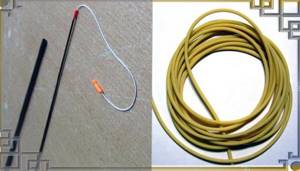
The diameter of the elastic is the main criterion. When catching small fish weighing no more than a kilogram, use a shock absorber up to 1.2 mm thick. Large individuals require an increase in this parameter. The length of the shock absorber directly affects the quality of the development of mining jerks - the shorter the element, the stiffer it is and the less it stretches. That is why you should install longer tires, which will have a reserve reserve when fishing. The thinnest models are built into the first two legs of the rod, and the thickest ones, such as carp ones, are built into three or four segments. Difficult choice of tires causes beginners to make mistakes, so at the initial stage you should consult with more experienced comrades, and also look for information on your own.
To learn more:
How to tie 2 hooks on a float rod?
Reasons why an angler should prefer fly tackle
The main competitor of fly fishing gear is, of course, the “folk” fishing rod, equipped with guide rings and a reel - a kind of lake version of the well-known lap dog. The main reason why they prefer it is its versatility: such tackle will allow you to cover absolutely any fishing conditions, changing only the installation itself. And yet, in this situation, the mahu has something to answer:
- The fly fishing rod is the lightest, most elegant and delicate tackle. Its design is devoid of a spinning reel and guide rings, and therefore its weight is significantly less. The best models of fly fishing rods, having a length of 7-8 meters, weigh no more than 400 grams - fluff!;
- Working with fly tackle is more mobile and convenient. The fisherman does not need to operate the reel; casting can be done with one hand;
- Tackle for such fishing is characterized by increased mobility. Having a large number of attached equipment in a fishing bag, the angler has the opportunity to quickly replace it following changing fishing conditions - just unfasten the rig from the connector at the top of the form. To rebuild a fishing rod with rings, you will have to completely disassemble and re-tie the tackle;
- Good fly rods provide the ability to work at a distance of up to 12-14 meters from the shore without feeling discomfort. The blank's own length can reach 7-8 meters while maintaining the correct structure and low dead weight. A lap dog of similar length will be heavy and awkward, and its cost will be several times higher than the cost of a similar swing;
- The fly rod is perfect for fishing from a boat. Lightweight and compact, it gives you the opportunity to get great pleasure when playing fish. At the same time, a length of 7-8 meters is more than enough even for fishing in deep areas of the reservoir;
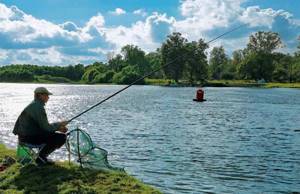
The circumstances described above are quite enough to understand the reasons for the popularity of this light and delicate tackle in our country. Everything finally falls into place when, using such a delicate “twig,” the angler hooks a fish weighing one and a half kilograms or more, receiving great pleasure from fishing. And then there will definitely be no turning back!
Strength and structure of the fly rod
The good strength of the fly rod is ensured, first of all, by the use of high-quality materials in the production, which are lightweight, but at the same time withstand heavy physical loads. The overall strength of the fishing rod also depends on the stiffness of the knees, which also determines the structure of the rod.
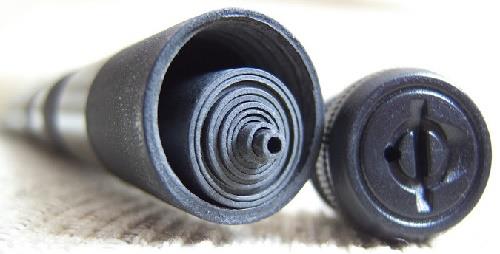
When creating a new model, computer diagnostics are carried out within the company’s walls, which makes it possible to achieve an optimal combination of parameters of length, test, construction and strength. Precise mathematical calculations lead to the creation of a truly convenient and reliable fishing rod, but they are not able to protect the product from careless handling in the future. To increase the durability of your fishing rod, don’t skimp on buying a cover and protect your fly rod from impacts.
